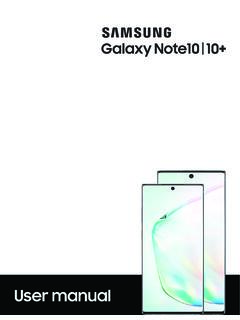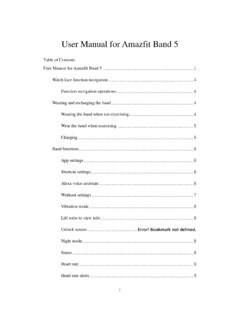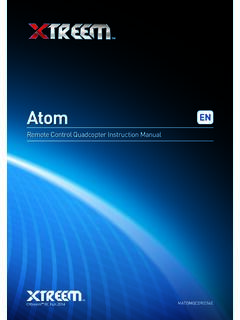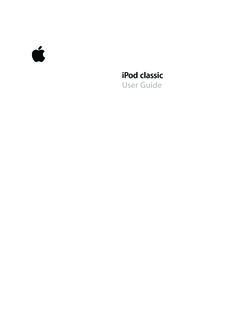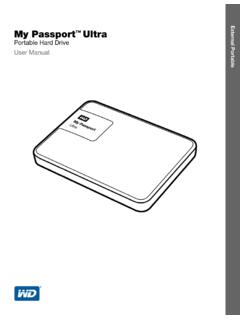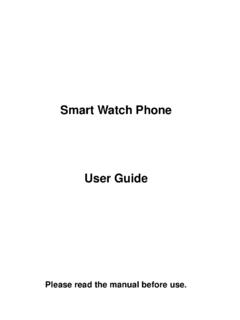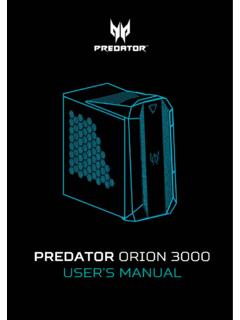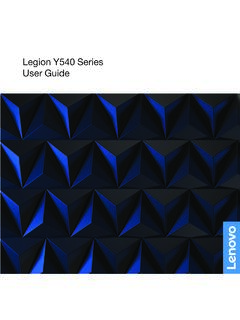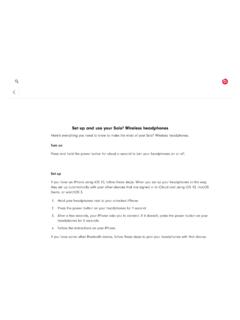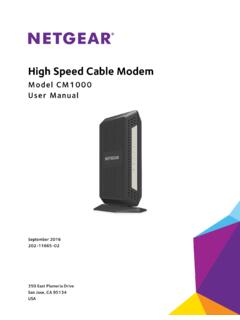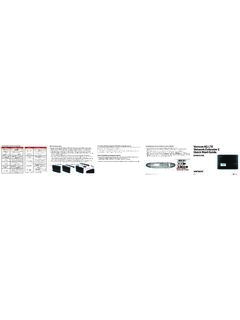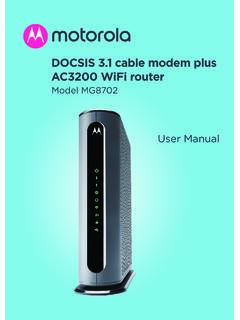Transcription of MacBook Pro User's Guide
1 MacBook Pro User s Guide Includes setup, expansion, and troubleshooting information for your MacBook Pro computer K Apple Computer, Inc. 2006 Apple Computer, Inc. All rights reserved. Under the copyright laws, this manual may not be copied, in whole or in part, without the written consent of effort has been made to ensure that the information in this manual is accurate. Apple is not responsible for printing or clerical Infinite LoopCupertino, CA Apple, the Apple logo, AirPort, AppleTalk, Final Cut Pro, FireWire, iCal, iDVD, iLife, iMovie, iPhoto, iPod, iTunes, Mac, Macintosh, and Mac OS are trademarks of Apple Computer, Inc., registered in the and other Express, Expos , FileVault, Finder, the FireWire logo, iSight, MacBook , Safari, Spotlight, SuperDrive, Tiger, and Xcode are trademarks of Apple Computer, Inc.
2 AppleCare, Apple Store, and iTunes Music Store are service marks of Apple Computer, Inc., registered in the and other is a service mark of Apple Computer, STAR is a registered Bluetooth word mark and logos are owned by the Bluetooth SIG, Inc. and any use of such marks by Apple Computer, Inc. is under and Intel Core are trademarks or registered trademarks of Intel Corporation or its subsidiaries in the United States and other company and product names mentioned herein are trademarks of their respective companies. Mention of third-party products is for informational purposes only and constitutes neither an endorsement nor a recommendation. Apple assumes no responsibility with regard to the performance or use of these product described in this manual incorporates copyright protection technology that is protected by method claims of certain patents and other intellectual property rights owned by Macrovision Corporation and other rights owners.
3 Use of this copyright protection technology must be authorized by Macrovision Corporation and is intended for home and other limited viewing uses only unless otherwise authorized by Macrovision Corporation. Reverse engineering or disassembly is Claims of Patent Nos. 4,631,603, 4,577,216, 4,819,098 and 4,907,093 licensed for limited viewing uses published in the United States and Canada. 3 Contents 7 Chapter 1: Getting Started8 Setting Up Your MacBook Pro 16 Basic Features of Your MacBook Pro 18 Keyboard Features of Your MacBook Pro 20 Additional Features of Your MacBook Pro 22 Putting Your MacBook Pro to Sleep or Shutting It Down 24 Calibrating Your Battery 25 Getting More Information 27 Chapter 2: Getting to Know Your MacBook Pro28 Adjusting Your Display 30 Using Your power Adapter 31 Using the Trackpad 33 Using the Keyboard 34 Using a Mouse 35 Using the Apple Remote and Front Row 39 Using the Built-in iSight Camera 42 Getting Answers Using Mac Help 4 Contents 44 Learning About Mac OS X 45 Customizing Your Desktop and Setting Your Preferences 46 Using Applications 47 When an Application Does Not Respond 47 Keeping Your Software Up to Date 48 Connecting to a Printer 49 Playing a CD and Connecting Headphones 50 Connecting a Camera or Other FireWire or USB Device 50 Transferring Files to Another Computer 53 Chapter 3.
4 Using Your MacBook Pro54 Using Universal Serial Bus Devices 57 Connecting with FireWire 61 Using ExpressCards 62 How AirPort Provides Wireless Internet Access 64 Using Bluetooth Wireless Technology 66 Connecting with Ethernet 67 Using External Video Support 71 Connecting Speakers and Other Audio Devices 72 Using Your SuperDrive 76 Understanding Sudden Motion Sensor Technology 77 Using Your Battery 81 Securing Your MacBook Pro Contents 5 83 Chapter 4: Adding Memory to Your MacBook Pro84 Installing Additional Memory 91 Making Sure Your MacBook Pro Recognizes the New Memory 93 Chapter 5: Troubleshooting94 Problems That Prevent You From Using Your Computer 96 Other Problems 99 Reinstalling the Software That Came With Your Computer 101 Using Apple Hardware Test 10 2 Installing Xcode Tools 10 2 Locating Your Product Serial Number 10 3 Appendix A: Specifications10 5 Appendix B: Safety, Use, and Care Information10 5 Understanding General Safety Instructions 10 6 Setting Up Your MacBook Pro and power Adapter 10 7 Using Your MacBook Pro 10 9 Avoiding Hearing Damage 111 Understanding Ergonomics 113 Apple and the Environment 115 Appendix C: Connecting to the Internet117 Gathering the Information You Need 6 Contents 119 Entering Your Information 121 Troubleshooting Your Connection 12 5 Appendix D.
5 Top Ten Questions131 Communications Regulation Information 13 5 Index 7 1 1 Getting Started Your MacBook Pro includes the following components: Important: Read all the installation instructions and safety information (see Safety, Use, and Care Information on page 105) carefully before you plug your computer into a power power cordApple RemotePower adapterDVI to VGA adapter MENU 8 Chapter 1 Getting Started Setting Up Your MacBook Pro Your MacBook Pro is designed so that you can set it up quickly and start using it right away. The following pages take you through the setup process, including these tasks: Plugging in the power adapter Connecting the cables Turning on your MacBook Pro Configuring a user account and other settings using Setup Assistant Step 1: Plug In the power Adapter If there is protective film around the power adapter, remove it before setting up your MacBook Insert the AC plug of your power adapter into an outlet and the power adapter plug into the MacBook Pro power adapter port.
6 As you get close to the port, you will feel a magnet, which helps draw and Guide the power adapter plug plug Chapter 1 Getting Started 9 To extend the reach of your power adapter, you can attach the AC power cord. First, pull up on the AC plug to remove it from the adapter, and then attach the included AC power cord to the adapter. Plug the other end into a power outlet. For an illustration, see page 30. Step 2: Connect Your Cables Next, for an Internet connection, connect your MacBook Pro to a DSL modem , cable modem , external modem , or Ethernet network. If you re connecting to a wireless AirPort Extreme network, you don t need information about types of connections, see Appendix C, Connecting to the Internet, on page 115. Warning: Make sure the AC plug is fully inserted into the power adapter and the electrical prongs on your AC plug are in their completely extended position before you plug the adapter into the power adapter plug power adapter portAC power cord AC plug 10 Chapter 1 Getting Started Note: Using a dial-up connection requires the external Apple USB modem , available for purchase from the online Apple Store at or from an Apple Authorized Reseller.
7 Plug the Apple USB modem into a USB port on the MacBook Pro, and then connect a phone cord (not included) from the modem into a phone wall jack. To connect to a DSL or cable modem or an Ethernet network:m Connect the cable to your DSL or cable modem as shown in the modem instructions, or connect the Ethernet cable to the Ethernet hub or outlet. Then connect the other end of the cable to the computer s Ethernet (G ) port. To connect wirelessly using AirPort:1 Turn AirPort on, if necessary, by choosing Turn AirPort on from the AirPort (Z ) status menu in the menu bar. AirPort detects available wireless networks. Ethernetcable Gigabit Ethernet port(10/100/1000 Base-T)G Chapter 1 Getting Started 11 2 Choose a network from the AirPort (Z ) status menu. Step 3: Turn On Your MacBook Pro 1 To turn on the MacBook Pro, press the power ( ) button briefly (up to 1 second).
8 Do not continue to hold down or press the power button after the startup tone or you might cause the computer to shut down you turn on the computer, you should see the sleep indicator light turn on (and stay on), and you should hear a takes the MacBook Pro a few moments to start up. After it starts up, the sleep indicator light turns off, and Setup Assistant opens automatically. 2 Use your MacBook Pro trackpad to select and move items on the screen, just like you use a mouse with a desktop computer. To move the arrow pointer on the screen, slide your finger across the trackpad. power buttonSleep indicator light 12 Chapter 1 Getting Started Important: Use only one finger on the trackpad to move the pointer. The trackpad is designed to allow scrolling when you use two fingers and the scrolling feature is turned on by default.
9 See Using the Trackpad on page 31 for more information. Use the trackpad button to select, click, or double-click items on the screen. TrackpadTrackpad button Chapter 1 Getting Started 13 Step 4: Configuring With Setup Assistant The first time you turn on your computer, Setup Assistant starts. Setup Assistant helps you enter your Internet and email information and set up a user account on your you already have a Mac, Setup Assistant can help you automatically transfer files, applications, and other information from your previous Mac to your new MacBook Pro. Problems Turning On the Computer? Nothing happens when you press the power ( ) button. The battery might be drained. Make sure that you plugged the power adapter firmly into both the computer and a power source.
10 The power adapter plug should light when you plug it into the computer. If the computer still doesn t start up, see Problems That Prevent You From Using Your Computer on page 94. You see a picture of a disk or a folder with a blinking question mark. This icon usually means that the computer can t find the system software on the hard disk or any disks attached to the computer. Disconnect all external peripherals and try restarting. Hold down the power ( ) button for 8 to 10 seconds until the computer turns off. Then press the power button again. If the problem persists, you might need to reinstall the system software. See Reinstalling the Software That Came With Your Computer on page 99. 14 Chapter 1 Getting Started To transfer information, make sure: Your other Mac has built-in FireWire and supports FireWire Target Disk Mode Your other Mac has Mac OS X or later installed You have a standard 6-pin to 6-pin FireWire cableSetup Assistant takes you through the process of transferring your information just follow the onscreen instructions.
